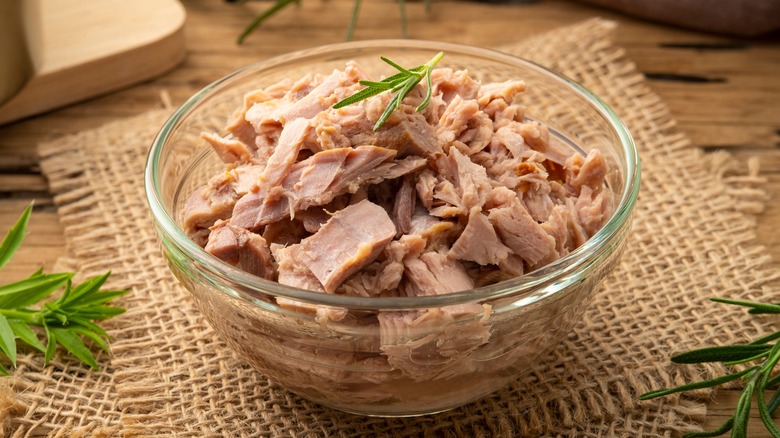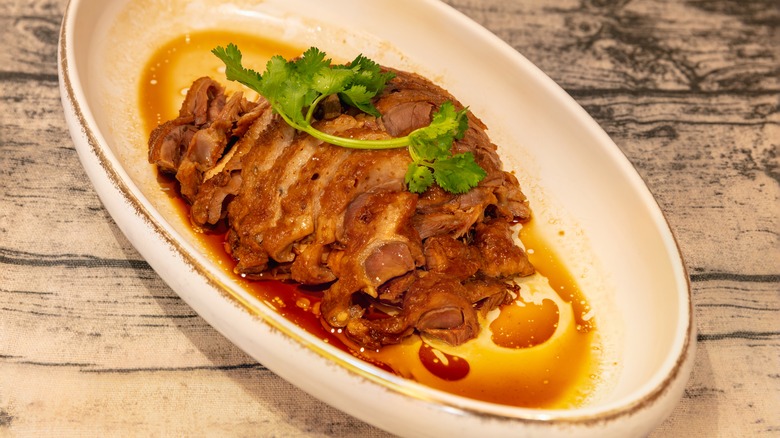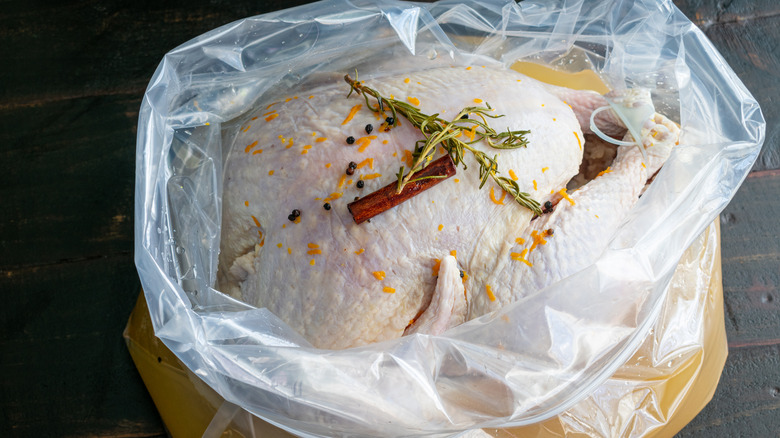Does Brining Meat Make An Actual Difference?
There are lots of different ways to improve a steak or a chicken breast, and if you've never experimented much with them, they tend to blend together like a bunch of spices. If you've never brined meat, then the word "brine" might bring up associations with pickles or the ocean, but soaking tough meat in a brine solution is a tried and true way to add flavor and moisture. A typical brine mixture consists of cold water, salt, and a little sugar (the water should be cold or lukewarm to avoid any accidental cooking). When you let meat soak in brine, a process called osmosis begins, and the flavors and moisture from the solution pass into the meat.
Salt does most of the heavy lifting in a brine solution, even though you don't need much of it. When you soak meat in brine, the salt interacts with the muscles in the meat, and the muscle fibers and proteins start dissolving in a way that tenderizes the meat. The result is a cut of meat that is juicier, softer, and flavored by salt and whatever else you've added to the brine.
Ideal meats for a brine soak
The best meats for brining are the kinds that tend to dry out more quickly, such as chicken and turkey — brining fried chicken in pickle juice is a great way to add flavor. Brine won't overpower any other flavors or spices you throw in, and basil, peppercorns, and garlic are all common flavorings for a chicken brine. Brining can be very useful for fixing up leftover poultry that has spent a night or two drying out and losing flavor in the fridge. A bit of brine and some reheating can make last night's chicken taste like new.
You don't need to restrict yourself to poultry, as salmon dishes such as lox famously involve brine solutions. Just make sure you're using low levels of salt, because high salt levels can create entirely different chemical reactions. Stick to ¾ cup of salt for every gallon of water, or three tablespoons of salt for every quart of water. If you're watching your sodium intake, keep in mind that there's still quite a lot of salt absorbed into the meat — it can absorb up to 10% of its weight in brine.
Brining, marinating, and curing
Compared to brining, the process of curing meat is similar but typically much more dry. In fact, brining is sometimes referred to as a "wet-cure," while curing is sometimes called "dry-brining". Curing usually only involves salt without any additional moisture, and while it may not be quite as ideal for adding flavor, it's a much better choice for making meat last longer: less moisture means fewer opportunities for bacteria to grow and spoil the food. Salt tends to draw out moisture that bacteria might otherwise need, leaving the meat as dry as possible (brining involves salt, but you are adding extra moisture).
It's more apt to compare brining to marinating, which uses acids to tenderize the meat instead of salt. Marinating is great for adding flavor, but you don't need to marinate steaks that are large and juicy. It's better for tenderizing thin, tough steaks, because a salty brine can sink deeper into the steaks than acid. We've been soaking our foods in brine for thousands of years, and we do it because it works.


